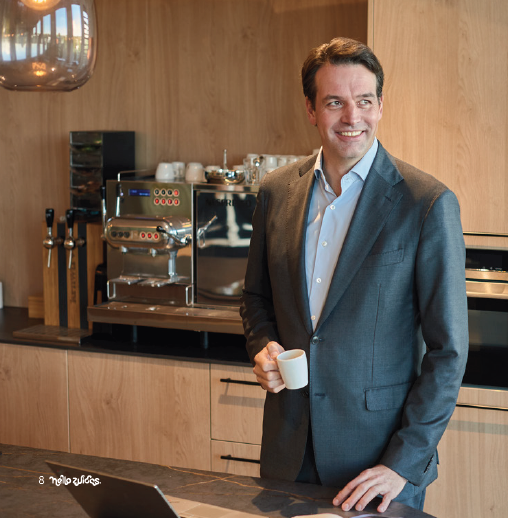Interview with Casper Veenman, transportation and automotive sector specialist at Roland Berger
“SOCIETAL ACCEPTANCE IS KEY TO REALIZING NEW MOBILITY SOLUTIONS”
Flying cars, personal transport drones, autonomous vehicles: thanks to rapidly advancing technologies, things that once felt futuristic are no longer looking quite so far-fetched. And maybe we shouldn’t be surprised, given all the packed trains and traffic-clogged roads we battle every morning. Still, how realistic or even desirable are these kinds of solutions in a mobility world that’s out of kilter and in which employers are grappling with ever more questions around sustainability and responsible travel? Casper Veenman is a partner at the international strategy consultancy firm Roland Berger and a transportation and automotive sector specialist, who has been helping clients navigate mobility issues for over 15 years. We sat down with him to get his take on current challenges and what the future may hold.
What kind of mobility advice are clients looking for at the moment?
“Many of the discussions with clients are about transitioning to a different form of mobility or an approach that will fundamentally change their strategy. For one thing, workers are less attached to their cars and prefer having more choices, so they have questions about that. But often it’s also about how to make mobility truly sustainable, or about advancing digitization and all the new applications it brings along. Things like the growth of autonomous transport and new technologies on the mobility front. These developments raise both technical and sustainablility related questions, but for clients the central one is really how it will influence their operations.”

There is a lot of talk about this massive mobility transition that’s supposedly happening. And yet, congested roads and overflowing trains are still a fact of daily life. To what extent are consumers feeling the effects of this development that’s meant to fix everything?
“Mobility is inherent to all of us. The average person travels an hour a day and spends 12% of their income on travel movements. And the government also invests substantially in mobility with some 10 billion euros annually. Consider the subsidy on electric cars and major infrastructure projects such as Zuidasdok. Car as a Service and other shared mobility solutions continue to grow in the coming years, especially in cities like Amsterdam. So, slowly but surely – and helped along by new technologies – gigantic shifts are taking place, though consumers may not feel the effects straightaway. But will we be able to pop over to Rotterdam any time soon without getting caught in traffic? No. That will take either a systemic change in how we use mobility investments, or a reconfiguration of people’s travel patterns. Theoretically, the motorways are wide enough to accommodate the traffic, but our habit of flocking to the office on Tuesday mornings causes them to block up. That means we need to use available resources more efficiently and rethink our habits.”
Looking at Zuidas, what are some of the positives of mobility in the district, and what could be better?
“Zuidas has it all. Public transport, underground bike parking, plenty of charging stations, we’re literally next to the motorway and we can practically see planes touching down at Schiphol. Zuidas is the ideal base because there are so many ways to get around, so there are solutions to fit everyone. The drawback is that the A10 motorway plus tall buildings are not a brilliant combination for air quality. It will take a while longer, but it was a sensible decision to move the motorway underground.”
What do you think the future of mobility will look like?
“It will be more flexible. You’ll be able to choose to get somewhere at any given moment in a way that fits your travel pattern, just as we already do here. Obviously, not every solution works in every location. Urban areas have far more potential for shared mobility than villages do, because it all hinges on population. But one thing is certain: old-fashioned ways of getting around, like the use of cars and bikes, won’t disappear. Instead, things will become electric and equipped with safety and autonomous features. Added to that will be a growing number of hybrid options. Take Biròs, which didn’t even exist a short time ago, or drones that one day might transport not only products but people as well. The pace of technology is moving super-fast, but much more is needed to get all these innovative ambitions off the ground. Not so much in terms of rules and regulations, as the societal acceptance to integrate them into our physical space and infrastructure. I think if we were to sit down here again ten years from now, a lot will have changed. But to the extreme you see in films? Probably not.”

Speaking of shared mobility, we’ve heard your firm has partnered with Felyx to offer a gap year programme. What does that entail?
“This is a programme offering professionals who are just starting out a chance to work at Roland Berger in Amsterdam for three months, followed by three months in Dubai and another three at a start-up, which in this case happens to be Felyx. It’s ideal for new grads who are just starting out but aren’t sure what to do yet. Should they travel the world? Or go to work somewhere? But where? That got us thinking: why not just try it all? Then you can decide what path to take afterwards. This lets people build relevant experience while also trying everything out. It’s a shame I’m not at the start of my own career, because I would have loved it.”
